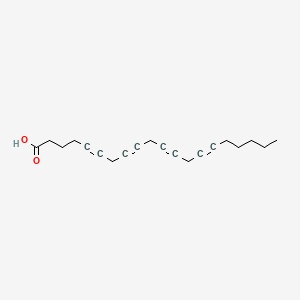| Lerner U |
Indomethacin inhibits bone resorption and lysosomal enzyme release from bone in organ culture. |
1980 |
Scand. J. Rheumatol. |
pmid:7455622
|
| Spies C et al. |
Inhibitory effects of mepacrine and eicosatetraynoic acid on cyclic GMP elevations caused by calcium and hormonal factors in rat ductus deferens. |
1980 |
Naunyn Schmiedebergs Arch. Pharmacol. |
pmid:6245377
|
| Smolen JE and Weissmann G |
Effects of indomethacin, 5,8,11,14-eicosatetraynoic acid, and p-bromophenacyl bromide on lysosomal enzyme release and superoxide anion generation by human polymorphonuclear leukocytes. |
1980 |
Biochem. Pharmacol. |
pmid:6245654
|
| Smolen JE and Weissmann G |
Lysosomal enzyme release from human granulocytes is inhibited by indomethacin, ETYA, and BPB. |
1980 |
Adv Prostaglandin Thromboxane Res |
pmid:6246788
|
| Boeynaems JM et al. |
In vitro effects of arachidonic acid and of inhibitors of its metabolism on the dog thyroid gland. |
1980 |
Prostaglandins |
pmid:6247748
|
| O'Flaherty JT |
Involvement of bivalent cations and arachidonic acid in neutrophil aggregation. |
1980 |
Inflammation |
pmid:6771213
|
| Bryant RW and Bailey JM |
Isolation of a new lipoxygenase metabolite of arachidonic acid, 8. 11, 12-trihydroxy-5,9,14-eicosatrienoic acid from human platelets. |
1979 |
Prostaglandins |
pmid:108769
|
| Bokoch GM and Reed PW |
Inhibition of the neutrophil oxidative response to a chemotactic peptide by inhibitors of arachidonic acid oxygenation. |
1979 |
Biochem. Biophys. Res. Commun. |
pmid:508315
|
| Sullivan TJ and Parker CW |
Possible role of arachidonic acid and its metabolites in mediator release from rat mast cells. |
1979 |
J. Immunol. |
pmid:762430
|
| Kalix P |
Prostaglandins cause cyclic AMP accumulation in peripheral nerve. |
1979 |
Brain Res. |
pmid:216462
|
